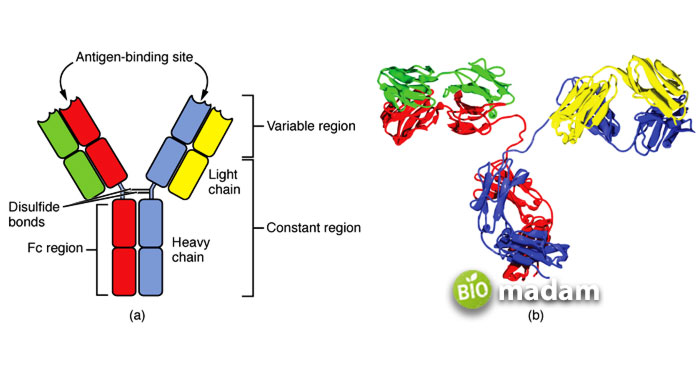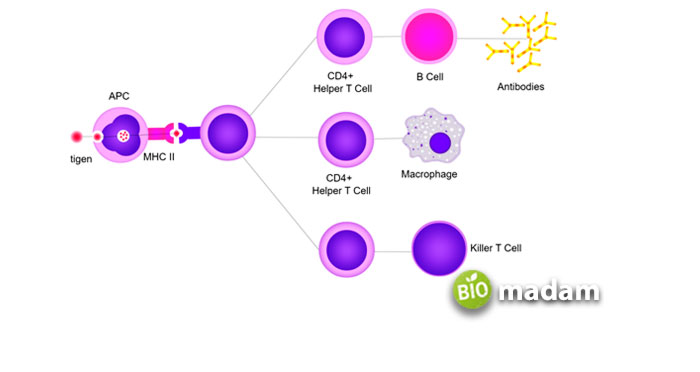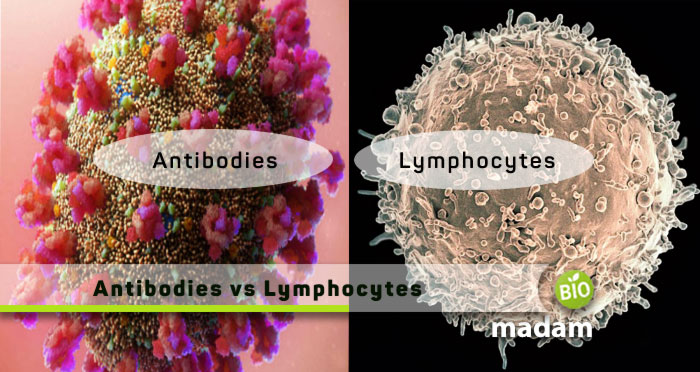Antibodies are essential to immunity, and so are lymphocytes. They contribute to protecting the body from infections and diseases by keeping the infection-causing agents away. They may include bacteria, viruses, protozoa, parasites, etc. Antibodies and lymphocytes in the body fight against these foreign agents to prevent the spread of disease in the body. Keep reading to learn all the differences between antibodies and lymphocytes.
Comparison Table
| Factors | Antibodies | Lymphocytes |
| Definition | Immunoglobulins fighting antigens | White blood cells killing pathogens |
| Location | Blood, mucus, lymph | Spleen, thymus, and lymph nodes |
| Structure | Y-shaped | Small, spherical, uninucleated cells |
| Functions | Identify and attach to harmful invaders | Produce antibodies to kill infected cells |
What are Antibodies?
Antibodies are a type of proteins the immune system produces in response to pathogens like bacteria, viruses, and toxins. Antibodies work by attaching themselves to antigens and preventing them from spreading further through the body.
The term “antigen” refers to any foreign substance that enters the body. Toxins, pathogens, allergens, venoms, and other biological hazards fall into this category. Anything that enters the body from the outside and tends to cause harm to the body may be categorized as an antigen.
The immune system responds to these antigens by producing a protein called an antibody or immunoglobulin to attack and destroy them. Our immune system is like a search-and-destroy team for the antigens entering our body. In this battle, antibodies play a crucial role. Different types of antibodies contribute to body immunity in specific ways.

Structure
Antibodies, when observed under an electron microscope, show a Y-shaped structure comprising four polypeptide units consisting of two light chains and two heavy chains. The two parallel polypeptide chains (amino acid sequences held together by peptide bonds) form the flexible Y shape, which is the fundamental structural unit of these proteins. The antibodies are made of globular proteins, also known as immunoglobulins.
The Y’s base comprises the terminal ends of two identical heavy chains, with the remaining segments of each heavy chain and a minor protein known as the light chain making up the Y’s arms. Both light chains share the same characteristics.
The constant region is a region of similarity between antibodies of the same class, encompassing the stem and the base of the arms. However, the sequence of the arm tips varies greatly. These points are where different antigens bind. Therefore, two antigen-binding sites at each end of an antibody differ significantly between antibodies.
Types of Antibodies
There are five main types of antibodies, each with a specific function. Besides the most widely known IgG and IgM, there are three more types. The five types of antibodies include:
- IgG: IgG is the most common antibody type found in all body fluids, including blood and plasma. Around 75% of all antibodies in the human body are IgG, or immunoglobulin G. It provides long-term immunity to infections and helps to neutralize toxins. It provides the secondary immune response.
- IgM: The first antibody produced by the immune system in response to an infection is IgM, which is present in the blood and lymph fluid. It helps fight the invading pathogen and activate other parts of the immune system. IgM helps B cells remember a pathogen after its destruction. If you’re re-exposed to the pathogen, your memory B cells help your immune system respond faster.
- IgA: It is a type of antibody found in mucous membranes that helps to protect against infections in the respiratory, gastrointestinal, and genitourinary tracts. The lamina propria is a thin layer within mucosal tissues that produces and secretes antibodies (15 percent of the body’s total antibody production).
- IgD: IgD antibody is located on B cells’ surface and involves the immune response. IgD comprises 0.25 percent of human antibodies. It “kick-starts” the immune response, but there is little knowledge about how it affects other parts of the immune system.
- IgE: IgE is an antibody involved in allergic reactions and helps to protect against parasites. B cells secrete IgE from lymph nodes and other lymphoid tissues near the allergen.
What are Lymphocytes?
The immune system contains numerous white blood cells, including lymphocytes. Lymphocytes circulate throughout the body to fight pathogens in case of interaction. They protect the body from various diseases and conditions arising from external pathogens. Lymph nodes, lymph tissue, and lymphatic organs all work together to form a complex network that serves as the immune system. Lymphocytes aid in antigen memory, meaning your immune system can recall previous encounters with specific pathogens.
The memory cells will immediately react if the same antigen is encountered again. This is why childhood diseases like measles and chickenpox rarely reappear in adulthood. For the same reason, vaccinations are effective against certain conditions.

Structure
Romanowsky polychromatic stains (e.g., Giemsa or Wright) of air-dried films reveal that most lymphocytes in normal blood are small, with an oval or kidney-shaped nucleus that stains purple and has densely packed nuclear chromatin. As measured in traditional blood and tissue studies, the diameters of lymphocytes range from 6 to 15 m when the cells are spread out on glass slides.
Types of Lymphocytes
Lymphocytes come in three varieties: B-cells, T-cells, and Natural killer cells (NK cells). They are structurally and functionally diverse. Specific surface proteins are present on lymphocytes of different subtypes. CD markers refer to markers that are part of a cluster of differentiation. Lymphocytes develop in the bone marrow that enters the bloodstream. Blood and lymphatic systems contain mature lymphocytes, which become T cells in the thymus gland and B cells in the lymph structures.
B-Lymphocytes: The function of these white blood cells is to provide humoral immunity. Somewhere around 20% of all white blood cells are macrophages. After releasing from the bone marrow, B cells congregate in the lymph nodes, respiratory tract, gastrointestinal tract, and spleen, where they wait to attack foreign pathogens. Following this initial encounter will produce plasma cells and memory cells. There are two distinct types of B lymphocytes. Plasma cells produce antibodies to mark the pathogen with the antibody so that phagocytes will engulf it when the cell attacks it. Alternatively, memory cells monitor the bloodstream for dangerous invaders and defend the body against them.
T Lymphocytes: The thymus is where T cells develop into their final form, hence the name “T cell.” The surface receptors on T cells can also recognize antigens, but unlike the surface antibody receptors on B cells, they do not directly bind to the antigens. T-cell receptors identify antigens presented by major histocompatibility complex (MHC) molecules, a type of protein in the cell and plasma membrane.
The development of T lymphocytes leads to the formation of two major subtypes. T cytotoxic (TC) cells contain CD8 membrane glycoprotein and class I MHC. They become cytotoxic T lymphocytes after activation. It removes virus-infected, cancerous, and foreign graft cells, etc. The regulatory T cell is a subset of the T cell that controls immune responses. T helper (TH) cells have surface-expressed CD4 glycoproteins that become active in response to peptide antigens on invading pathogens. They take quick action to preserve the immune system and release various cytokine proteins dependent on the state of the immune system. Memory T cells are long-lived, antigen-specific T cells. They’re crucial to the body’s ability to respond quickly after being re-exposed to a pathogen. This group is in charge of the backup plan.
Natural Killer Cells: NK cells are part of innate immunity and lack antigen-specific receptors. They kill tumors and infected cells. MHC class I surface molecules distinguish normal cells from infected or cancerous cells. Interferons activate NK cells. Natural killer cells kill infected cells when activated.
Difference between Antibodies and Lymphocytes
Definition
Antibody
Antibodies are immunoglobulins that bind to antigens or disrupt pathogen processes.
Lymphocyte
Lymphocytes are white blood cells that are part of the immune system and circulate throughout the body. They protect the body from illness and infection.
Location
Antibody
Body fluids like blood, mucus, and lymph contain antibodies.
Lymphocyte
Alternatively, lymphocytes are typically found in the lymphatic system, which includes the lymph nodes, spleen, and thymus.
Functions
Antibodies
They have built-in programming to identify and attach to harmful invaders like viruses, bacteria, and other parasites.
Lymphocyte
Whereas lymphocytes are white blood cells that include T and B cells. The B cells are responsible for producing antibodies, while T cells destroy infected cells.
Structure
Antibody
Two heavy chains and two light chains comprise the four polypeptide chains that comprise an antibody. Each antibody has a distinct shape and binding ability due to the specific arrangement of these chains. They give a Y-shape look due to the specific binding of the chains.
Lymphocyte
Contrarily, lymphocytes are small, spherical cells that have one nucleus.
Production
Antibody
Antibodies develop by B cells in response to the presence of pathogens.
Lymphocyte
On the other hand, lymphocytes develop in the thymus and mature before releasing into the bloodstream.
Contribution to Immunity
Antibody
Antibodies play a crucial part in the immune system by binding to and neutralizing harmful substances, thereby tagging them for elimination by other immune cells.
Lymphocyte
Cell-mediated immunity is vital in warding off infections brought on by viruses and other intracellular pathogens, and lymphocytes, especially T cells, are pivotal in this process.
The Bottom Line
Antibodies and lymphocytes are essential to fighting off diseases caused by antigens and pathogens that enter the body. Lymphocytes are small, simple cells, while antibodies comprise a complex Y-shaped structure that consists of two polypeptide chains. The main difference between antibodies and lymphocytes is their location and mechanism. Antibodies are typically present in blood, mucus, and lymph, whereas lymphocytes are found in the spleen, lymph nodes, and thymus.

Anna has completed her degree in Pharmacy from the University of Hawaii. She is serving as a research assistant in a pharmaceutical company. She had a great interest in writing blogs, traveling to different parts of the US, and trying delicious recipes in her spare time.

